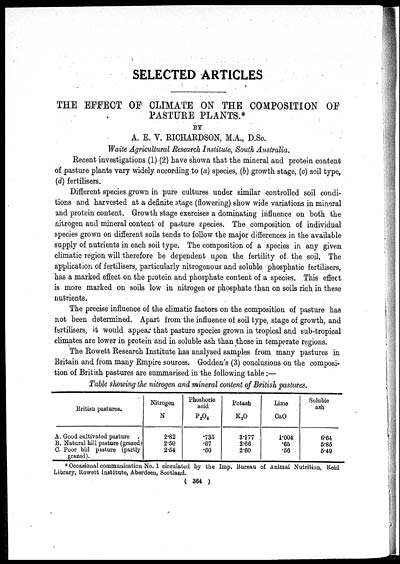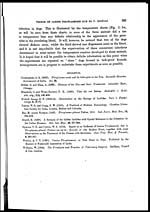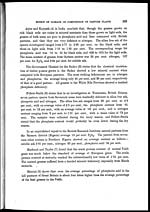Medicine - Veterinary > Veterinary colleges and laboratories > Indian journal of veterinary science and animal husbandry > Volume 3, 1933 > Original articles > Effect of climate on the composition of pasture plants
(465) Page 364
Download files
Individual page:
Thumbnail gallery: Grid view | List view

SELECTED ARTICLES
THE EFFECT OF CLIMATE ON THE COMPOSITION OF
PASTURE PLANTS.*
BY
A. E. V. RICHARDSON, M.A., D.Sc.
Waite Agricultural Research Institute, South Australia.
Recent investigations (1) (2) have shown that the mineral and protein content
of pasture plants vary widely according to (a) species, (b) growth stage, (c) soil type,
(d) fertilisers.
Different species grown in pure cultures under similar controlled soil condi-
tions and harvested at a definite stage (flowering) show wide variations in mineral
and protein content. Growth stage exercises a dominating influence on both the
nitrogen and mineral content of pasture species. The composition of individual
species grown on different soils tends to follow the major differences in the available
supply of nutrients in each soil type. The composition of a species in any given
climatic region will therefore be dependent upon the fertility of the soil. The
application of fertilisers, particularly nitrogenous and soluble phosphatic fertilisers,
has a marked effect on the protein and phosphate content of a species. This effect
is more marked on soils low in nitrogen or phosphate than on soils rich in these
nutrients.
The precise influence of the climatic factors on the composition of pasture has
not been determined. Apart from the influence of soil type, stage of growth, and
fertilisers, it would appear that pasture species grown in tropical and sub-tropical
climates are lower in protein and in soluble ash than those in temperate regions.
The Rowett Research Institute has analysed samples from many pastures in
Britain and from many Empire sources. Godden's (3) conclusions on the composi-
tion of British pastures are summarised in the following table:—
Table showing the nitrogen and mineral content of British pastures.
|
British pastures. |
Nitrogen |
Phoshoric |
Potash |
Lime |
Soluble ash |
|
N |
P2O5 |
K2O |
CaO |
||
|
A. Good cultivated pasture |
2.82 |
.735 |
3.177 |
1.004 |
6.64 |
|
B. Natural hill pasture (grazed) |
2.50 |
.67 |
2.66 |
.66 |
5.85 |
|
C. Poor hill pasture (partly grazed). |
2.54 |
.60 |
2.60 |
.56 |
5.49 |
* Occasional communication No. 1 circulated by the Imp. Bureau of Animal Nutrition, Reid
Library, Rowett Institute, Aberdeen, Scotland.
(364)
Set display mode to: Large image | Zoom image | Transcription
Images and transcriptions on this page, including medium image downloads, may be used under the Creative Commons Attribution 4.0 International Licence unless otherwise stated. ![]()
| Permanent URL | https://digital.nls.uk/75231193 |
|---|
| Description | Covers articles from 1933. |
|---|




